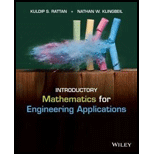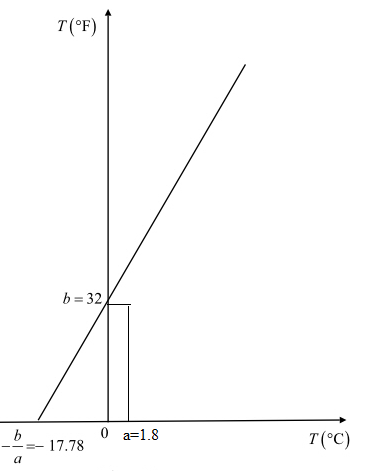
Concept explainers
To obtain the linear relationship between the Fahrenheit and Celsius temperature scales, the freezing and boiling point of water is used as given in the table below:

The relationship between the temperatures in Fahrenheit and Celsius scales satisfies the linear equation
(b) Sketch the graph of
(c) Using the graph obtained in part (b ), find the temperature interval in °C if the temperature is between 20°F and 80°F.
Want to see the full answer?
Check out a sample textbook solution
Chapter 1 Solutions
Introductory Mathematics for Engineering Applications
Additional Math Textbook Solutions
Precalculus
College Algebra with Modeling & Visualization (5th Edition)
University Calculus: Early Transcendentals (4th Edition)
Calculus: Early Transcendentals (2nd Edition)
STATISTICS F/BUSINESS+ECONOMICS-TEXT
A Problem Solving Approach To Mathematics For Elementary School Teachers (13th Edition)
- Don't use any Al tool show ur answer in pe n and paper then take 20. Solve the given system of differential equations: x' = x+y, x(0) = 0 y' = 2x, y(0) = 1arrow_forward4. Verify the Cauchy-Goursat theorem for the function f(z) =225z around the closed curve C defined by a half circle || = 1 from the point (1,0) to (-1, 0) in the counterclockwise direction and then the straight line from (-1,0) to (1,0). Don't use any Al tool show ur answer in pe n and paper then takearrow_forward2. Evaluate the following integral using cauchy integral theorem: ||=3 sin (22)+cos (22) (2-1)(2-2) -dz Don't use any Al tool show ur answer in pe n and paper then takearrow_forward
- 18. Solve the given differential equation: y' + y = f(t), y(0) = 5, where f(t) = 0arrow_forward16. Solve the given differential equation: y" + 4y Given, = sin (t)u(t2), y(0) = 1, y'(0) = 0 1 = (x² + 1)(x²+4) 1/3 -1/3 + x²+1 x²+4 Don't use any Al tool show ur answer in pe n and paper then takearrow_forwardNo chatgpt pls will upvotearrow_forward^^ QUESTION 1. Two photos in total, I wrote the questionOnly 100% sure experts solve it correct complete solutions need to get full marks it's my quiz okkkk.take your time but solve full accurate okkk Geometry maths expert solve itarrow_forwardAll 6 questions in the image. Thank youarrow_forwardNo chatgpt pls will upvotearrow_forwardthese are solutions to a tutorial that was done and im a little lost. can someone please explain to me how these iterations function, for example i Do not know how each set of matrices produces a number if someine could explain how its done and provide steps it would be greatly appreciated thanks.arrow_forwardQ1) Classify the following statements as a true or false statements a. Any ring with identity is a finitely generated right R module.- b. An ideal 22 is small ideal in Z c. A nontrivial direct summand of a module cannot be large or small submodule d. The sum of a finite family of small submodules of a module M is small in M A module M 0 is called directly indecomposable if and only if 0 and M are the only direct summands of M f. A monomorphism a: M-N is said to split if and only if Ker(a) is a direct- summand in M & Z₂ contains no minimal submodules h. Qz is a finitely generated module i. Every divisible Z-module is injective j. Every free module is a projective module Q4) Give an example and explain your claim in each case a) A module M which has two composition senes 7 b) A free subset of a modale c) A free module 24 d) A module contains a direct summand submodule 7, e) A short exact sequence of modules 74.arrow_forwardProve that Σ prime p≤x p=3 (mod 10) 1 Ρ = for some constant A. log log x + A+O 1 log x "arrow_forwardarrow_back_iosSEE MORE QUESTIONSarrow_forward_ios
 Advanced Engineering MathematicsAdvanced MathISBN:9780470458365Author:Erwin KreyszigPublisher:Wiley, John & Sons, Incorporated
Advanced Engineering MathematicsAdvanced MathISBN:9780470458365Author:Erwin KreyszigPublisher:Wiley, John & Sons, Incorporated Numerical Methods for EngineersAdvanced MathISBN:9780073397924Author:Steven C. Chapra Dr., Raymond P. CanalePublisher:McGraw-Hill Education
Numerical Methods for EngineersAdvanced MathISBN:9780073397924Author:Steven C. Chapra Dr., Raymond P. CanalePublisher:McGraw-Hill Education Introductory Mathematics for Engineering Applicat...Advanced MathISBN:9781118141809Author:Nathan KlingbeilPublisher:WILEY
Introductory Mathematics for Engineering Applicat...Advanced MathISBN:9781118141809Author:Nathan KlingbeilPublisher:WILEY Mathematics For Machine TechnologyAdvanced MathISBN:9781337798310Author:Peterson, John.Publisher:Cengage Learning,
Mathematics For Machine TechnologyAdvanced MathISBN:9781337798310Author:Peterson, John.Publisher:Cengage Learning,






